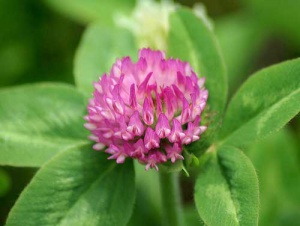Red Clover
Contents
Habitat & Description
Red Clover is a short-lived perennial that can be found growing widely throughout Europe, North America, Asia and many other parts of the world. Atop their branched stems, the plants are crowned with reddish colored flowers. Some other common names for this herb are bee-bread, daidzein, genistein and cow, purple, meadow or wild clover.
Constituents & Actions
Red Clover consists of isoflavones (water-soluble chemicals that act like estrogens), flavonoids, phytoestrogens, salicylates and volatile oil. This herb is a rich source of calcium, chromium, magnesium, niacin, phosphorus, potassium, thiamine and vitamin C. It acts as an alterative (cleanser, aids in removal of waste products), expectorant (loosens and removes phlegm from respiratory tract) and anti-spasmodic (prevents or relieves spasms).
Medicinal Uses
Although this herb is most popularly used by women, it's also praised for treatment of male health issues and has been used holistically for a wide range of problems.
Women have long used Red Clover for menopausal problems such as hot-flashes or night-sweats. It is a well-known alternative to traditional HRT (hormone replacement therapy), without the dangerous side-effects. It is also helpful for pre-menstrual syndrome (PMS). Red Clover also assists with bone-loss and mineral density which often lead to osteoporosis in later years.
The isoflavones from the extract of Red Clover are found to be of great benefit in the treatment of prostate, liver and sexual problems in men. Use of this herb has also been shown to reduce PSA levels.
Red Clover has a history in the treatment and prevention of cancers, breast in particular. This herb also may boost the immune system. It's expectorant and anti-spasmodic effects make it widely used in cases of cough (especially whooping cough), bronchitis and salivary gland congestion.
Combined with yellow dock and nettle, this herb works well for skin problems. As an ointment, it can be applied externally for treatment of psoriasis, eczema and rashes.
Available Forms, Preparation & Dose
Red Clover is available in teas, tinctures, tablets, capsules, liquid extract and ointments. To prepare an infusion, pour one cup of boiling water onto 1-3 tsp. of dried herb, infuse for 10-15 minutes, and drink three times per day. The tincture can be taken in doses of 2-6ml, 3x's daily.
Interactions and Side-Effects
This herb is not know to have any serious side-effects, however some cautions should be taken when using Red Clover. It may increase the effects of estrogen when using along with HRT or birth control pills.
Consult with your doctor if on prescription medications, as Red Clover may interfere with the body's ability to process some drugs broken down by liver enzymes. It may interfere when using tamoxifen. Also, this herb may enhance the effects of anticoagulants (blood-thinners), therefore increasing the risk of bleeding.
Related Discussion
- Red Clover Benefits
- Relief for Hot Flashes & Night Sweats?
- Red Clover Extract vs. BPH
- Red Clover Inhibits Aromatase - Breast Cancer Implications
